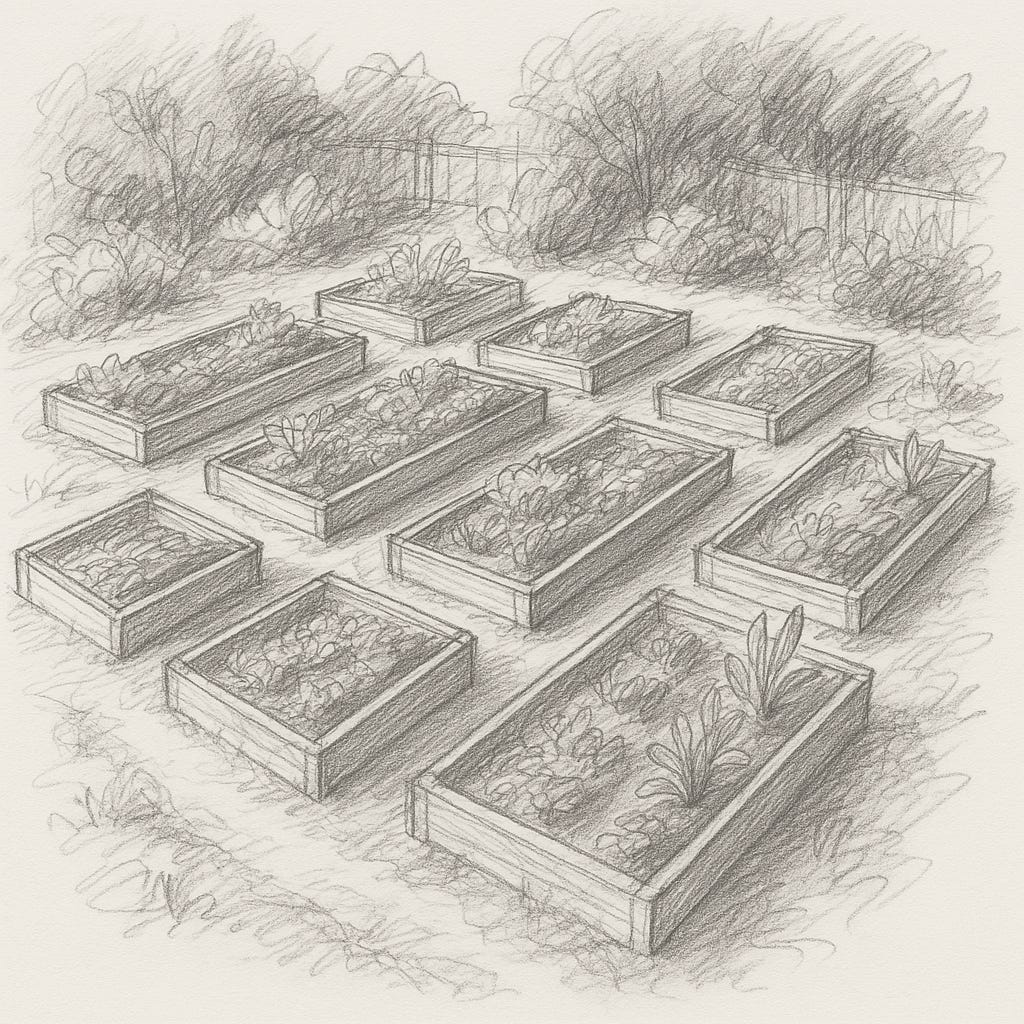Crop Rotation by Family
Many gardening experts consider crop rotation to be a good way avoid a number of problems, but to do that well, one must first understand the vegetable families.
As the term indicates, crop rotation is simply the practice of planting different things in different places each year - but this begs the question - what makes things different from one another? Thankfully, biologists have been grappling with just this very question for quite some time, and have organized the categorization of all life into a system of taxonomic rank, of which the main categories are: domain, kingdom, phylum, class, order, family, genus and species. Since it is at the rank of “family” that, arguably, the relevant distinctions start to arise - I think that’s the best organizing principle for crop rotation, aside from other concerns like the availability of light and the height of plants1.
The families
There are nine families that cover the vast majority of garden vegetables (mostly annuals, or plants we treat like annuals) for which crop rotation makes sense. Here they are:
Amaranthaceae: we can think of this as the “spinach” family” since spinach is (arguably) the most popular form of amaranth. Aside from spinach, it also includes things like beets, Swiss Chard, lambs quarters, and quinoa.
Amaryllodaceae - we can think of this as the “onion family”. Aside from onions, it also includes things like shallots, scallions, chives and garlic.
Apiaceae - we can think of this as the parsley family, since everything in it has leaves like parsley. Aside from parsley, it also includes things like carrots, parsnips, celery, and fennel.
Asteraceae - we can think of this as the “lettuce family”, although it’s probably more accurate to call it the daisy family. Aside from lettuce, it also includes things like artichokes, chicory, endives, sunchokes, sunflowers, and dandelions .
Asteraceae - we can think of this as the “mustard” family, since all the seeds resemble mustard seeds, though in ours gardens, it it most often their leaves and sometimes roots that we grow them for. Aside from mustard greens, it includes things like kale, cabbage, collards, arugula, Brussels sprouts, turnips, kohlrabi and many other popular cruciferous2 vegetables .
Cucurbitaceae - we can think of this as the “squash” family. The seeds all have a similar shape,a nd they all have a similar growth pattern Aside from squash, it also includes things like cucumbers, melons, pumpkins and zucchini.
Fabaceae - we can think of this as the “pea” family” . These plants are often referred to as legumes and are noted for their nitrogen-fixing capacity - an important feature where crop-rotation is concerned. Aside from peas, it includes things like beans, and lentils .
Poaceae - we can think of this as the “grass family”, since everything in it has a grass-like growing habit, although it is the seeds of these plants that we eat. Corn is the most typical plant from this family found in gardens, although it also includes wheat, barley and oats.
Solanaceae - we can think of this as the “potato” family, although they are often referred to as nightshades and are known for their toxicity, despite yielding so many of gardeners most favorite vegetables. Aside from potatoes, it also includes things like tomatoes, peppers, and eggplants.
Grouping Mentality
Deciding where everything should go is a little like a puzzle, and I think it would take an entire article to lay out a range of different strategies for different situations. The key is to try to have it so that any given bed is given a multiple-year break from each type of plant, to whatever extent that is feasible depending on the things that are being grown.
In my garden I try to make the multiple-year interval 4 years, and I try to make sure that each bed gorew peas or beans every 4 years. For instance, every four years a specific bed can have tomatoes, or potatoes, or peppers, or eggplant (solanaceae family). In the other three years, it needs to have something else, and ideally, in one of those years it has be something from the fabaceae family (peas/beans) to help the soil recover with its nitrogen fixing properties.
Final Thoughts
Many home gardeners question the necessity of crop-rotation, and I know that some boast of having planted the same things in the same beds for years with no consequences at all in terms of pests, diseases or productivity. I am sure this is entirely possible, especially if the bed is having organic matter added each year to keep nutrient levels optimal - but for me, the risk of pests or diseases moving in, combined with the relative simplicity of the practice of crop rotation makes doing it a no-brainer. I realize that this article has only laid down the foundation of a crop rotation approach, so next week I will explore a range of approaches to crop rotation that are based on plant family types.
FREE SHIPPING FROM VESEYS SEEDS
Use my NEW coupon code “GAVS25” to get free shipping from Veseys Seeds on seed catalogue orders. Free shipping is not applicable on surcharges on larger items. Promo code is valid until November 30, 2025.
Any garden that has spots that don’t get good light - so crop rotations cannot cycle in plants that need a lot of sun to these places. The height of plants also matters, because tall plants can cast shade on smaller plants and rob them of sunlight - so, generally, tall plants should not be directly South of short plants, and in some cases it might not also be good to have them directly easy or west or shorter plants.
They are called “cruciferous” because their flowers take the shape of a crucifix (aka “cross”, of biblical reference).





I think #5 is meant to be Brassicaceae? Breaking rotation into families like this is helpful, makes it easier to remember!